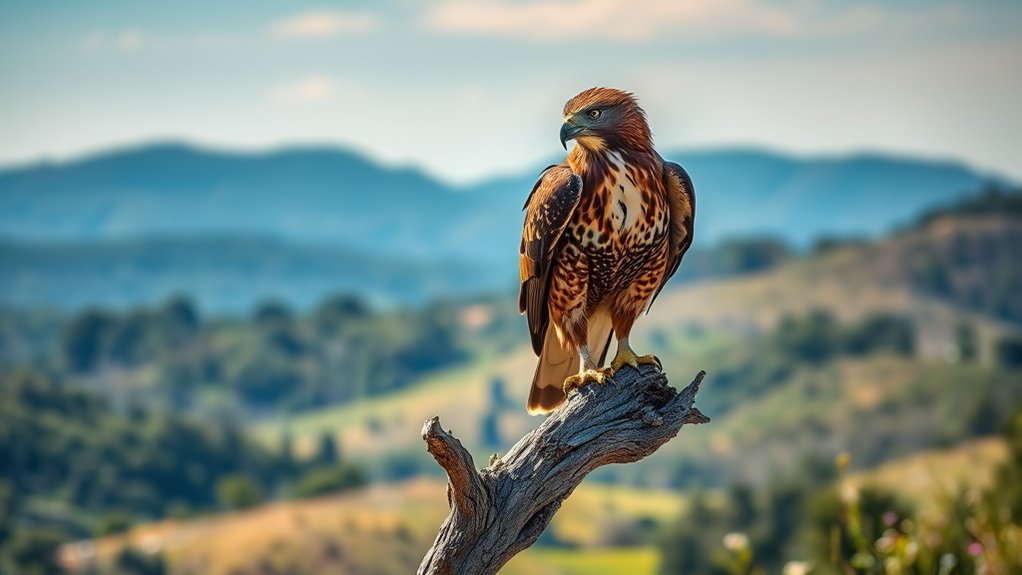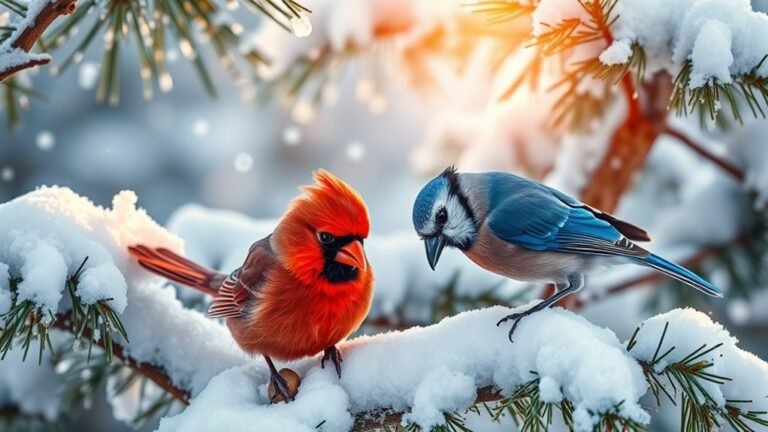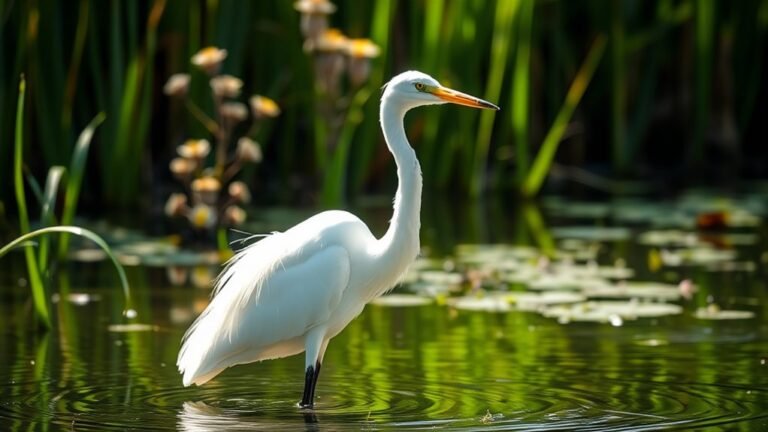Hawks in Georgia: Identification and Behavior Guide
Hawks in Georgia have unique traits and behaviors that help identify them. Learning to recognize these raptors can deepen your appreciation for how they adapt and hunt. For example, the Red-tailed Hawk often soars high in the sky, while the Cooper's Hawk prefers to hunt in dense forests.
These birds face challenges in their environments, such as habitat loss and food scarcity. Understanding these issues can help inform conservation efforts and highlight the importance of hawk watching in Georgia. Enjoy observing these remarkable birds as they thrive in their habitats.
Key Takeaways
Hawks in Georgia include the Red-tailed Hawk, Cooper's Hawk, and Broad-winged Hawk. Each species has unique physical traits that make them easy to identify.
Hawks hunt using their sharp eyesight. They employ a perch and pounce method to catch small mammals and birds.
Nesting happens high in trees. Both parents build the nest and care for two to five eggs during the breeding season.
Habitat loss poses a threat to hawk populations. Community conservation efforts are important to protect their nesting and hunting areas.
Good places to view hawks include Kennesaw Mountain and the Okefenokee National Wildlife Refuge. These locations allow for observing different hawk species in their natural settings.
Overview of Hawks in Georgia
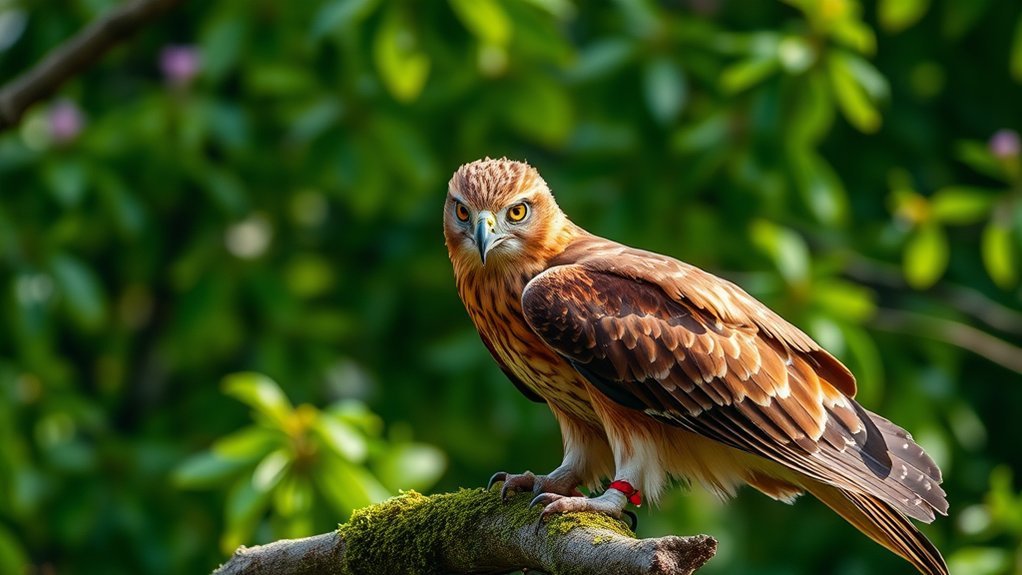
Hawks play a significant role in Georgia's wildlife. Various species live in both cities and rural areas.
These birds thrive in open fields, woodlands, and parks. Hawks adapt to different environments, which helps them find food. They mainly hunt small mammals, birds, and reptiles. Their sharp eyesight allows them to spot prey from high places.
Some hawks also scavenge for carrion when needed. Learning about where hawks live and what they eat is important. They help control pest populations and keep nature balanced.
Common Hawk Species Found in Georgia
In Georgia, you can find several common hawk species, each with distinct traits. The Red-tailed Hawk is frequently seen in open fields and woodlands. Its call is easy to recognize.
Cooper's Hawks prefer dense habitats like forests and suburbs. They're agile hunters of smaller birds. The Sharp-shinned Hawk also thrives in wooded areas and is known for its quick flying style.
These hawks use specific calls to communicate, especially during mating seasons. Learning about their habitats and sounds enhances your appreciation for them.
This connection can deepen your experience of nature in Georgia. Enjoy observing these fascinating birds as they play an important role in the ecosystem.
Red-tailed Hawk: Identification and Characteristics
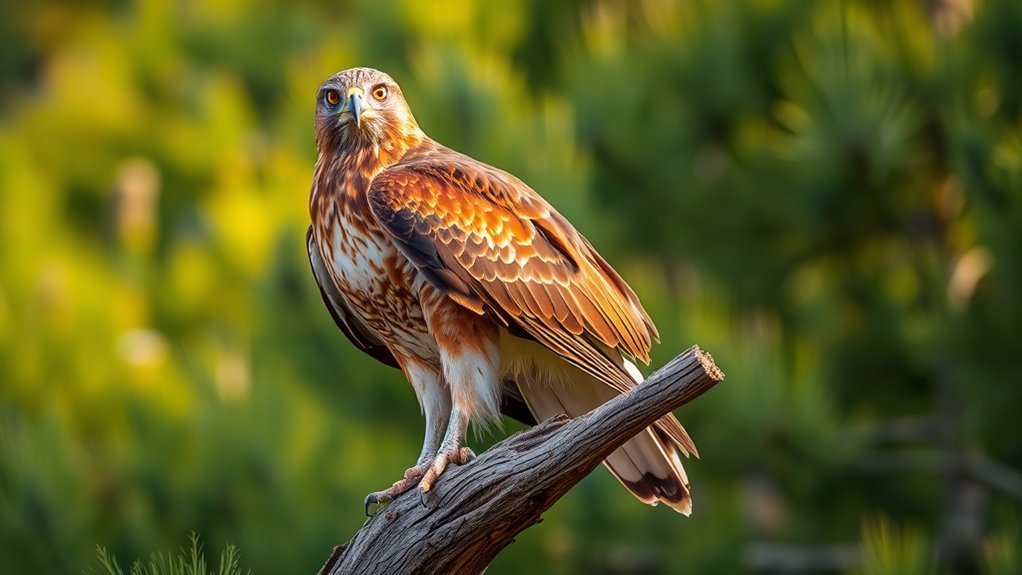
The Red-tailed Hawk is a well-known bird of prey in Georgia. It has several distinctive features that make it easy to spot:
- An unmistakable reddish-brown tail, especially in adult birds.
- Dark brown feathers on its back and a cream-colored belly with streaks.
- A large wingspan that typically measures between 44 to 52 inches.
This hawk can be found in many habitats across North America, such as forests, mountains, and open fields, which helps explain why it's common in Georgia.
Its diet mainly consists of small mammals, birds, and reptiles. This hunting behavior plays an important role in managing local pest populations.
Learning about these features enhances appreciation for the Red-tailed Hawk's vital contribution to Georgia's ecosystem.
Cooper's Hawk: Identification and Characteristics
The Cooper's Hawk is a skilled bird of prey known for its hunting abilities. To identify this hawk, look for its long tail and rounded wings, which help it move quickly through forests.
Adult Cooper's Hawks have a slate-blue-gray back and a rusty-orange barred underbelly, making them noticeable. Males are smaller, measuring about 14 to 20 inches in length, while females can grow up to 24 inches.
A key feature to recognize is the reddish barring on their chest and a white throat. These traits help you appreciate the Cooper's Hawk as you observe this fascinating predator in Georgia's ecosystems.
Sharp-shinned Hawk: Identification and Characteristics

The Sharp-shinned Hawk is a small and quick bird of prey found in Georgia.
It has specific features that help with identification:
- A small, squared tail with clear banding.
- A compact body with a small head.
- A reddish-brown barred chest that stands out against its blue-gray wings.
To identify a Sharp-shinned Hawk, observe its size and tail shape closely.
This hawk is an agile hunter, often seen pursuing songbirds in wooded areas.
Recognizing these traits can enhance your birdwatching experience in Georgia and increase your appreciation for these fascinating birds.
Red-shouldered Hawk: Identification and Characteristics
The Red-shouldered Hawk is easy to spot when you're in Georgia. It has bright coloring and unique sounds that stand out among other hawks. This bird often lives in areas with deciduous forests and wetlands. You can see it sitting on low branches or flying overhead.
To identify the Red-shouldered Hawk, look for its dark wings and reddish underparts. It also has a thin, banded tail.
Listen for its call; it sounds like a series of loud, slightly descending "keek" notes. These vocalizations help distinguish it from other hawk species.
Seeing a Red-shouldered Hawk indicates a healthy environment. Birdwatchers and nature enthusiasts find this hawk interesting due to its specific habitat preferences. Observing it can enhance your appreciation of local wildlife.
Broad-winged Hawk: Identification and Characteristics
Spotting a Broad-winged Hawk in Georgia is exciting for birdwatchers. This hawk prefers habitats like deciduous forests and areas near open spaces during migration.
Watching their behaviors can enhance your experience:
- They soar smoothly on thermal currents, displaying their broad wings.
- During migrations, you might see groups of them flying together, which is an impressive sight.
- Their call is a sharp whistle, making it easier to identify them.
To increase your chances of seeing these beautiful hawks, look at forest edges or wetlands.
Every outing can be a chance to connect with nature and observe these remarkable birds.
Key Identification Features of Hawks
Identifying hawks in Georgia can make birdwatching more enjoyable. Focus on key features like size, shape, and feather patterns.
For example, Red-tailed Hawks have broad wings and dark tails, while Cooper's Hawks are thinner with longer tails. Look for color differences, which can include light browns and deep reds.
Observe their behaviors and hunting styles, as these can help confirm which species you see. Learning these traits will improve your skills and enrich your experience with Georgia's birds.
Hawk Behavior and Hunting Techniques
Hawks in Georgia display specific behaviors and hunting techniques that highlight their survival skills. Their ability to adapt to their surroundings plays a significant role in their success as hunters.
Here are important aspects of hawk feeding and hunting:
- Soaring and Scanning: Hawks soar high in the sky. They look for movement below to find prey.
- Perch and Pounce: They often sit on trees or poles. From these spots, they use their sharp vision to spot food. Then, they swoop down quickly to catch it.
- Diverse Diet: Hawks eat various foods, including small mammals and birds. Their diet changes based on what's available, showing their adaptability.
Nesting and Reproduction Habits
Hawks in Georgia are skilled hunters, but their nesting and reproduction habits are also important for survival.
During breeding season, you can see their mating rituals. These rituals include aerial displays and sounds that strengthen their bond. After pairing, hawks build nests. They choose high places like tree branches or cliffs. They gather materials such as twigs, grass, and feathers to make a strong nest for their young.
Hawks usually lay two to five eggs. Both parents take turns incubating the eggs. This teamwork helps ensure that the hatchlings survive.
The commitment hawks have to their young and territory is evident in their careful nesting and parenting.
Migration Patterns of Georgian Hawks
As the seasons change, hawks in Georgia begin their migrations. They travel long distances to find better climates and food sources.
Understanding their migration patterns is important for bird lovers. Here's what you need to know about hawk migration in Georgia:
- Seasonal Timing: Most hawks migrate south from late summer through early fall. They return in spring, following a clear seasonal schedule.
- Flight Routes: Hawks often fly along specific paths, like the Appalachian Mountains, to help them fly safely and conserve energy.
- Adaptability: Hawks change their routes based on weather and food supply, showing their ability to adapt.
Enjoy watching these amazing birds as they embark on their journeys!
Conservation Status and Threats Facing Hawks
Many hawks in Georgia face serious threats that impact their populations. Habitat loss is a major concern. Urban development and agriculture reduce the spaces where hawks nest and hunt.
You can help protect hawks by supporting habitat preservation efforts. These initiatives aim to safeguard vital areas for these birds.
Hunting regulations are another important factor for hawk survival. Strict enforcement of these rules is essential to prevent overharvesting and keep hawk populations stable.
It's important for you and your community to advocate for these measures. Every action contributes to securing a future for Georgia's hawks.
You can join local conservation groups or take part in awareness campaigns. This involvement can deepen your appreciation for these impressive birds and support their ongoing protection.
Your effort matters.
Tips for Spotting Hawks in the Wild
To spot hawks in the wild, focus on their habitats and behavior. Hawk watching can be exciting. Here are three clear tips to help you:
- Check Open Areas: Hawks hunt in fields, meadows, and near water. These spots help them see potential prey easily.
- Look Up: Hawks often sit on tree branches and telephone poles. They perch to look for food.
- Be Patient: Wildlife photography takes time. Hawks may not appear right away, so bring your gear and enjoy the wait.
Enjoy your time outdoors. Connecting with nature brings you closer to wildlife.
Resources for Further Hawk Watching in Georgia
Georgia provides many resources for hawk watchers who want to learn more about these amazing birds. You can join local birdwatching clubs that arrange events and share important information about where hawks live and how they behave.
The Georgia Ornithological Society website offers guides and updates on popular hawk watching spots. Great places to see different hawk species include Kennesaw Mountain and Okefenokee National Wildlife Refuge.
Using field guides for hawk identification will help you recognize the various types of hawks. Additionally, you can connect with other hawk watchers through online forums or social media groups. Here, you can exchange tips and experiences.
Using these local resources will make your hawk watching experience more enjoyable.
Frequently Asked Questions
What Are the Best Times to Observe Hawks in Georgia?
To observe hawks in Georgia, watch for them during migration seasons in fall and spring. These are the times when hawks are most active. You can also increase your chances of seeing them by looking for hunting activities at dawn or dusk. This way, you can enjoy the beauty of these birds in their natural habitat.
Can Hawks Be Found in Urban Areas of Georgia?
Yes, hawks live in urban areas of Georgia. They adapt well to city environments. You can often see them nesting on tall buildings. They also use parks to hunt for food. Their ability to thrive in cities shows how well they can coexist with humans.
How Can I Attract Hawks to My Backyard?
To attract hawks to your backyard, provide high perches and create nesting spots. You can also use feeding techniques, like placing small rodents where they can be easily seen, to encourage these beautiful birds to visit your space.
Are Hawks Aggressive Towards Pets or Small Animals?
Hawks can behave aggressively towards small pets. They may see them as food. To keep your pets safe, watch your yard carefully. Set up safe areas where your pets can play and roam without worry.
What Role Do Hawks Play in the Ecosystem?
Hawks are important for keeping the ecosystem balanced. They help control rodent populations, which allows other predators to thrive. This predator control contributes to overall biodiversity. When hawks are present, it signals a healthy environment, supporting a vibrant community of plants and animals. Their role is crucial for maintaining the health of various ecosystems.

Kashvi is a passionate bird enthusiast and nature lover who has been fascinated by the world of birds for years. With a keen eye for detail and a love for learning, Kashvi is dedicated to sharing her knowledge and insights with fellow bird enthusiasts on Avian Enthusiasts. Through her engaging and informative articles, Kashvi aims to inspire others to join her in exploring the fascinating world of birds and to promote a deeper appreciation for these incredible creatures.

